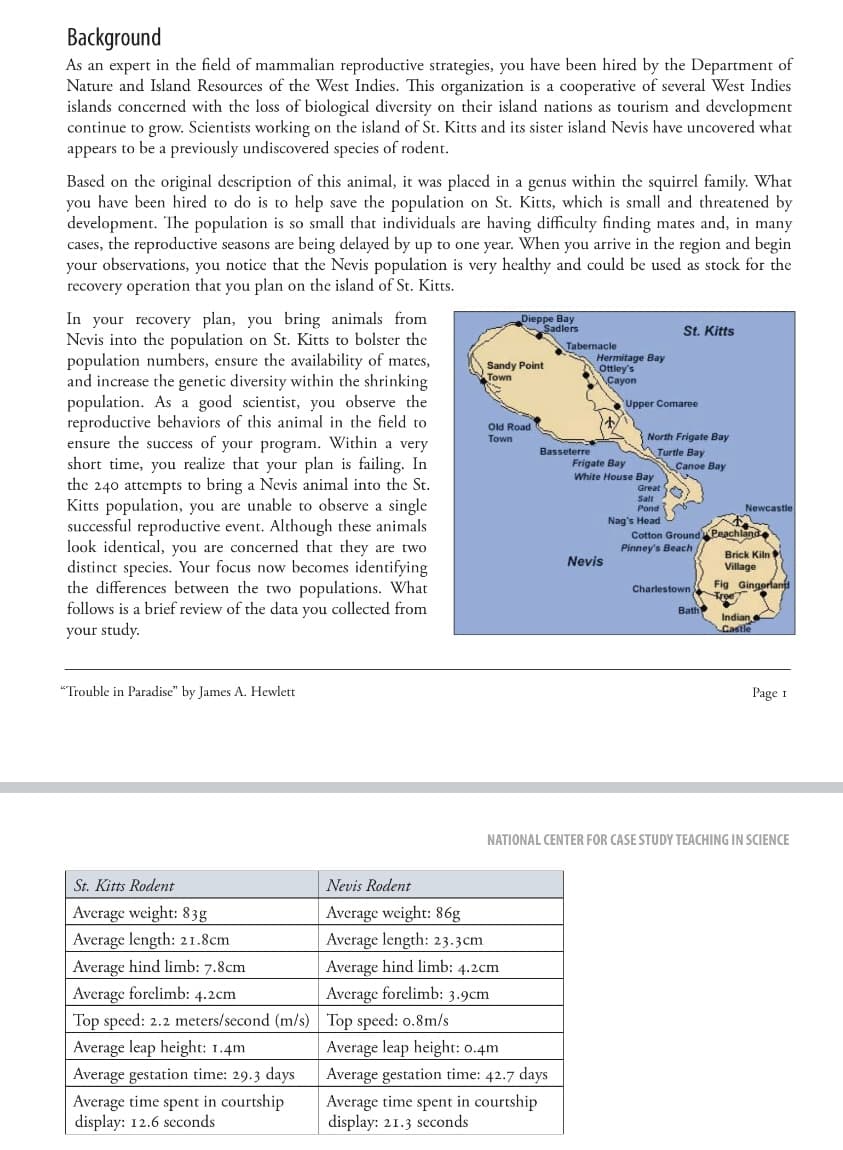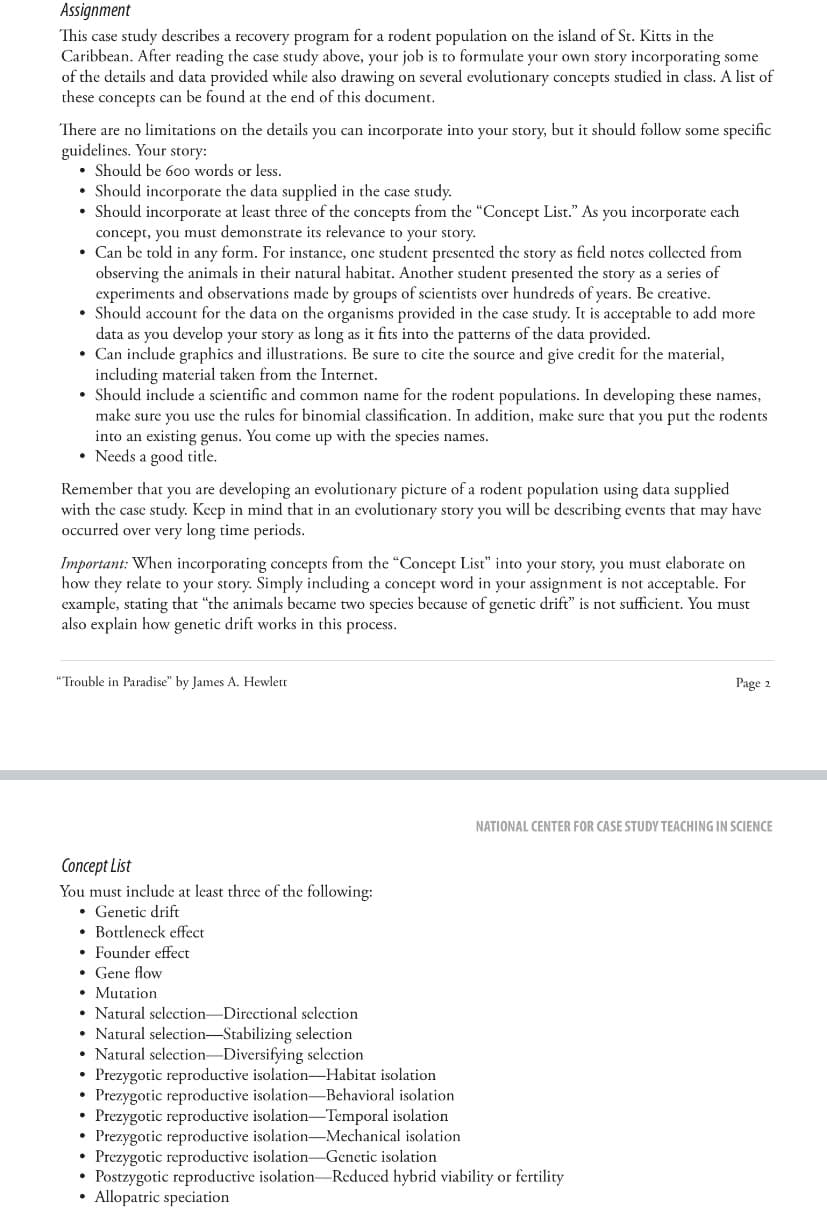This case study describes a recovery program for a rodent population on the island of St. Kitts in the Caribbean. After reading the case study above, your job is to formulate your own story incorporating some of the details and data provided while also drawing on several evolutionary concepts studied in class. A list of these concepts can be found at the end of this document. There are no limitations on the details you can incorporate into your story, but it should follow some specific guidelines. Your story: • Should be 600 words or less. • Should incorporate the data supplied in the case study. • Should incorporate at least three of the concepts from the "Concept List." As you incorporate each concept, you must demonstrate its relevance to your story. • Can be told in any form. For instance, one student presented the story as field notes collected from observing the animals in their natural habitat. Another student presented the story as a series of experiments and observations made by groups of scientists over hundreds of years. Be creative.
This case study describes a recovery program for a rodent population on the island of St. Kitts in the Caribbean. After reading the case study above, your job is to formulate your own story incorporating some of the details and data provided while also drawing on several evolutionary concepts studied in class. A list of these concepts can be found at the end of this document. There are no limitations on the details you can incorporate into your story, but it should follow some specific guidelines. Your story: • Should be 600 words or less. • Should incorporate the data supplied in the case study. • Should incorporate at least three of the concepts from the "Concept List." As you incorporate each concept, you must demonstrate its relevance to your story. • Can be told in any form. For instance, one student presented the story as field notes collected from observing the animals in their natural habitat. Another student presented the story as a series of experiments and observations made by groups of scientists over hundreds of years. Be creative.
Biology Today and Tomorrow without Physiology (MindTap Course List)
5th Edition
ISBN:9781305117396
Author:Cecie Starr, Christine Evers, Lisa Starr
Publisher:Cecie Starr, Christine Evers, Lisa Starr
Chapter16: Population Ecology
Section: Chapter Questions
Problem 1DID
Related questions
Question

Transcribed Image Text:Background
As an expert in the field of mammalian reproductive strategies, you have been hired by the Department of
Nature and Island Resources of the West Indies. This organization is a cooperative of several West Indies
islands concerned with the loss of biological diversity on their island nations as tourism and development
continue to grow. Scientists working on the island of St. Kitts and its sister island Nevis have uncovered what
appears to be a previously undiscovered species of rodent.
Based on the original description of this animal, it was placed in a genus within the squirrel family. What
you have been hired to do is to help save the population on St. Kitts, which is small and threatened by
development. The population is so small that individuals are having difficulty finding mates and, in many
cases, the reproductive seasons are being delayed by up to one year. When you arrive in the region and begin
your observations, you notice that the Nevis population is very healthy and could be used as stock for the
recovery operation that you plan on the island of St. Kitts.
In your recovery plan, you bring animals from
Nevis into the population on St. Kitts to bolster the
population numbers, ensure the availability of mates,
and increase the genetic diversity within the shrinking
population. As a good scientist, you observe the
reproductive behaviors of this animal in the field to
ensure the success of your program. Within a very
short time, you realize that your plan is failing. In
the 240 attempts to bring a Nevis animal into the St.
Kitts population, you are unable to observe a single
successful reproductive event. Although these animals
look identical, you are concerned that they are two
distinct species. Your focus now becomes identifying
the differences between the two populations. What
follows is a brief review of the data you collected from
your study.
"Trouble in Paradise" by James A. Hewlett
St. Kitts Rodent
Average weight: 83g
Average length: 21.8cm
Average hind limb: 7.8cm
Average forelimb: 4.2cm
Top speed: 2.2 meters/second (m/s) Top speed: 0.8m/s
Average leap height: 1.4m
Average gestation time: 29.3 days
Average time spent in courtship
display: 12.6 seconds
Nevis Rodent
Average weight: 86g
Average length: 23.3cm
Dieppe Bay
Sadlers
Sandy Point
Town
Old Road t
Town
Average hind limb: 4.2cm
Average forelimb: 3.9cm
Tabernacle
Basseterre
Average leap height: 0.4m
Average gestation time: 42.7 days
Average time spent in courtship
display: 21.3 seconds
Hermitage Bay
Ottley's
Cayon
Nevis
Upper Comaree
Frigate Bay
White House Bay
Great
St. Kitts
North Frigate Bay
Turtle Bay
Salt
Pond
Nag's Head
Canoe Bay
Cotton Ground
Pinney's Beach j
Charlestown
Bath
Newcastle
Peachland
Brick Kiln
Village
Tree
Fig Gingerfang
403
Indian
Castle
NATIONAL CENTER FOR CASE STUDY TEACHING IN SCIENCE
Page 1

Transcribed Image Text:Assignment
This case study describes a recovery program for a rodent population on the island of St. Kitts in the
Caribbean. After reading the case study above, your job is to formulate your own story incorporating some
of the details and data provided while also drawing on several evolutionary concepts studied in class. A list of
these concepts can be found at the end of this document.
There are no limitations on the details you can incorporate into your story, but it should follow some specific
guidelines. Your story:
Should be 600 words or less.
• Should incorporate the data supplied in the case study.
• Should incorporate at least three of the concepts from the "Concept List." As you incorporate each
concept, you must demonstrate its relevance to your story.
• Can be told in any form. For instance, one student presented the story as field notes collected from
observing the animals in their natural habitat. Another student presented the story as a series of
experiments and observations made by groups of scientists over hundreds of years. Be creative.
• Should account for the data on the organisms provided in the case study. It is acceptable to add more
data as you develop your story as long as it fits into the patterns of the data provided.
• Can include graphics and illustrations. Be sure to cite the source and give credit for the material,
including material taken from the Internet.
Should include a scientific and common name for the rodent populations. In developing these names,
make sure you use the rules for binomial classification. In addition, make sure that you put the rodents
into an existing genus. You come up with the species names.
• Needs a good title.
Remember that you are developing an evolutionary picture of a rodent population using data supplied
with the case study. Keep in mind that in an evolutionary story you will be describing events that may have
occurred over very long time periods.
Important: When incorporating concepts from the "Concept List" into your story, you must elaborate on
how they relate to your story. Simply including a concept word in your assignment is not acceptable. For
example, stating that "the animals became two species because of genetic drift" is not sufficient. You must
also explain how genetic drift works in this process.
"Trouble in Paradise" by James A. Hewlett
Concept List
You must include at least three of the following:
• Genetic drift
Bottleneck effect.
• Founder effect
• Gene flow
• Mutation
• Natural selection Directional selection
• Natural selection-Stabilizing selection
• Natural selection Diversifying selection
Page 2
NATIONAL CENTER FOR CASE STUDY TEACHING IN SCIENCE
• Prezygotic reproductive isolation-Habitat isolation
Prezygotic reproductive isolation-Behavioral isolation
• Prezygotic reproductive isolation-Temporal isolation
• Prezygotic reproductive isolation-Mechanical isolation
Prezygotic reproductive isolation-Genetic isolation
• Postzygotic reproductive isolation-Reduced hybrid viability or fertility
Allopatric speciation
Expert Solution
This question has been solved!
Explore an expertly crafted, step-by-step solution for a thorough understanding of key concepts.
This is a popular solution!
Trending now
This is a popular solution!
Step by step
Solved in 4 steps

Knowledge Booster
Learn more about
Need a deep-dive on the concept behind this application? Look no further. Learn more about this topic, biology and related others by exploring similar questions and additional content below.Recommended textbooks for you

Biology Today and Tomorrow without Physiology (Mi…
Biology
ISBN:
9781305117396
Author:
Cecie Starr, Christine Evers, Lisa Starr
Publisher:
Cengage Learning

Biology Today and Tomorrow without Physiology (Mi…
Biology
ISBN:
9781305117396
Author:
Cecie Starr, Christine Evers, Lisa Starr
Publisher:
Cengage Learning